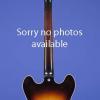The Mother of All Thinbody Electric Guitars!
This 18 1/2-inch-wide thinbody (just under 2 inches deep) guitar weighs just 7.10 lbs. and has a huge, fat nut width of just under 1 3/4 inches and scale length of 25 1/2 inches. Laminated curly maple body, seven-piece maple and walnut neck with a typical late '62/early '63 medium thick profile, and ebony fretboard with 20 medium flat jumbo frets and inlaid pearl block position markers with abalone "V" inserts at frets one, three, five, seven, nine, and twelve, and a pearl block (without the abalone "V" insert) at fret fifteen. The body of the guitar has nine-ply binding on the top and back, the f-holes are triple-bound, the headstock is triple-bound, the neck is single-bound, and the fretboard is single-bound with two white lines on each side. Headstock with inlaid pearl "Epiphone" script logo and pearl "Vine of Life" inlay. Three-layer (black/white/black) dome-shaped plastic truss-rod cover with single retaining screw. The serial number ("62348") is impressed into the back of the headstock. Individual Grover Imperial tuners with stairstep metal buttons. Three nicely balanced Epiphone "PAF" mini-humbucker pickups with outputs of 7.16k, 7.66k, and 7.20k, each with a rectangular black label on the underside with "Patent Applied For" in gold lettering and with all of the solder joints untouched. Inside the bass f-hole is an Epiphone (Kalamazoo, Michigan) rectangular blue label with "Emperor" and "E112T" typed in black and the serial number ("62348") stamped in black. Black plastic pickguard with five-layer (white/black/white/black/white) plastic binding and with large Epiphone stylized "E" logo in silver. Four controls (two volume, two tone) on lower treble bout plus three-way pickup selector switch on upper bass bout. Gold plastic bell-shaped knobs with metal tops. Rosewood bridge with pre-set compensating saddle on rosewood base and Epiphone Frequensator tailpiece. All hardware gold-plated. The top of the guitar is nicely flamed, as is the back of the neck. The back of the guitar has a beautifully subtle "birds-eye" maple grain. This guitar, which has been under the bed for forty-three years and only just surfaced, is in mint (9.50) condition. It is literally as new -- a time-warp! Housed in the original Epiphone five-latch tan hardshell case with burgundy plush lining (9.25). Complete with the original hang-tag.
"The Epiphone room at the [July 1958 NAMM show at the Palmer House hotel in Chicago] did attract a crowd wishing to see the new models...The centerpiece of the display was an Emperor electric, which was designated as the first of the new Epis. The show generated modest orders...Gibson had built prototypes to show, but may not have been ready to put the guitars into production...If any were shipped in 1958, they weren't entered into Gibson shipping records that year. Epi sales picked up in 1959, when Gibson shipped a total of 1,458 Epiphone guitars. After a small increase in 1960 to 1,750 units, Epiphones began to catch on...By 1965, Epiphone's share of the total had risen to almost 20 percent" (Walter Carter, Epiphone: The Complete History, p. 61).
"Epiphone in the sixties is usually regarded as an almost-Gibson line -- primarily because Epi pickups were a bit smaller and Epi solidbodies were a bit thinner than those of their Gibson cousins -- but the Epi line of the early sixties included some models that rivaled or even surpassed anything in the Gibson line, in price as well as in appeal...In the early sixties, the Epiphone Emperor electric with natural finish listed for $850 -- $250 more than the top Gibson thinline, the Byrdland, and about $40 more than even Gibson's highest-priced model, the Johnny Smith (which was a full-depth archtop)" (Walter Carter, Epiphone: The Complete History, p. 63).
“While the name certainly dated back to Epiphone’s New York days—an Emperor archtop acoustic had first been offered by the company in the mid 1930s—Gibson’s new electric version [Epiphone Emperor] had a thinline body, which was certainly unlike anything that the tradition-based Epiphone had produced. Gibson also disposed of the electric Emperor’s distinctive six-button pickup control panel, replacing it with conventional ‘two and two’ volume and tone knobs...At first Gibson offered the new Epiphones in sunburst or natural finishes, but from 1965 the Emperor was available only in sunburst” (Tony Bacon, The History of the American Guitar from 1833 to the Present Day, p. 95).
“The Emperor went from full-depth to thinbody but maintained its place at the top of the line. With a body width listed at 18 1/2 inches, it is the widest standard model Gibson ever made. The Emperor retains the three pickups of the earlier Zephyr Emperor Regent. The knob placement is odd for a Gibson—almost all other f-hole models have the four knobs configured around the f-hole—but is standard for this model. The multiple laminations of the neck and the shape of the peghead indicate that the neck was part of the stockpile of parts acquired by Gibson with the purchase of Epiphone” (George Gruhn and Walter Carter, Electric Guitars and Basses: A Photographic History, p. 217).
When introduced in 1958, the thinbody Emperor Electric had three New York pickups. By 1961, it had three mini humbuckers. By 1963 the Emperor was available by special order only and by 1965 only Sunburst was available. The Emperor thinline was finally discontinued altogether in 1969. It was Epiphone's (and Gibson's) most expensive guitar -- appearing in the 1961 Epiphone price list at $750.00 for the Sunburst -- a full $290.00 more than the next most expensive Epiphone, the Sheraton.
Translate:

